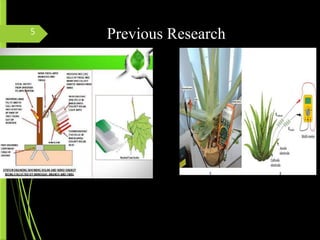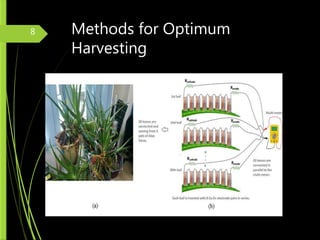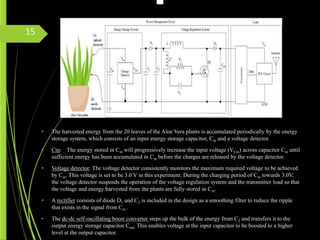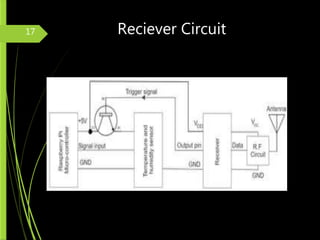Application of Aloe Vera Based PBC in Powering Wireless Device
- 1. Application of Aloe Vera Based PBC in Powering Wireless Device
- 2. 1. Introduction 2. Previous Research 3. Anatomy of the Plant 4. Designing of Power Management Circuit 5. Methods for Energy Harvesting 6. Conclusion and Results 7. References 2 CONTENTS
- 3. • Electricity has itself been an innovative invention, but with decades the use of natural resources for the production of electricity and other power generating items has increased the severity of pollution. The use of harmful components in making such batteries and e-cells has made the surroundings a harmful radiation zone. • It is well proven that electrical energy can be harvested from the living plants which can be used as a potential renewable energy source for powering wireless devices in remote areas where replacing or recharging the battery is a difficult task. Therefore, harvesting electrical energy from living plants in remote areas such as in farms or forest areas can be an ideal source of energy as these areas are rich with living plants. • The presentation gives design of a power management circuit that can harness, store and manage the electrical energy which is harvested from the leaves of Aloe Vera plants to trigger a transmitter load to power a remote sensor. The experimental results show that the electrical energy harvested from the Aloe Vera under a specific setup condition can produce an output of 3.49 V and 1.1 mA. • This proves that this new source of energy combined with a power management circuit can be employed for powering the wireless sensor network for application in the Internet of Things (IoT). Introduction 3
- 4. • Energy harvesting is a widely focused research area which is targeted to derive electrical energy from external sources which can be stored to power up small autonomous electronic devices. • Numerous techniques have been proposed to recharge the batteries such as photovoltaic cells, wind energy, kinetic energy, radio frequency, magnetic field and thermoelectric. These power sources may face the dilemma of their spasmodic availability throughout the day. • The proposed technique harvests the electrical energy from the living plants that can provide energy to a load throughout the day as long as the plants remain alive. This energy harvesting technique is feasible to be adapted in an area where living plants are abundantly available such as in farms or forest. • We have proposed a power management circuit, which can harvest the electrical energy from the Aloe Vera plants and converts the plants into a plant-based cell (PBC) to activate a remote sensor via a wireless transmission 4
- 6. • electrical energy was harvested from a Bigleaf maple tree (Acer Macrophyllum) which was fed to two specialized nano-electronic ICs which consisted of a boost converter and a low frequency timer • The system could power the circuit in a nanoscale due to its minute energy. Maple Tree (Acer Macrophyllum) • Succulent plants are water-retaining plants, which can store water in their leaves, stems, and roots to survive in a dry environment. Due to this condition, the succulent family of plants that have a higher conductivity can generate a higher current • The electrical energy harvested from the living plant can be stored in a capacitor which can be used as a potential energy source to activate low power consumption devices such as a wireless transmitter paired to a sensor. Aloe Vera Plant (Barbarus Miller) • The electrical energy harvested from the tree was measured at 0.8 V and 3 uA. It was fed to a prototype circuit consisted of an intermittent power- gated supply circuit, storage capacitor and a DC-DC converter. The circuit could boost the electrical energy harvested from the plant from 0.8 V to 2.0 V. • The generated voltage was subsequently used to power a 300 MHz wireless transmitter. Pachira Tree (Pachira Aquatic) 6
- 7. ANATOMY OF ALOE VERA PLANT Aloe Vera plant is a type of water-retaining plant from the succulent species of plants, which can survive in an arid environment for a long period. It is a single stem plant growing at a height of approximately 50 cm to 100 cm with its large basal leaves growing in a spiral pattern around its stem at the center with thick fibrous root. This plant is termed as "Lily of Desert" for its ability to store a high amount of water in its leaves. Its leaves are green, thick and fleshy with spiny edges at both sides. The first layer is the Aloe Vera rind which is a green outer layer covering the leaf to protect its inner layers The second layer is the Aloe latex, which is a sap between the Aloe rind and the inner fleshy part The third layer is a clear inner semi-solid fleshy gel which is rich in nutrients and contains 99% water, and 1% of polysaccharides, glucomannans, lipids, amino acids, vitamins, sterols, minerals, and enzymes. This part is the largest portion of the leaf substance, which serves as the water storage reservoir for the plant. This part of the leaf also acts as an electrolyte in the electrochemistry process to generate electrical energy. 7
- 9. Methods for Optimum Energy Harvesting This research focuses on the investigation of the parallel connection between higher numbers of leaves among multiple Aloe Vera plants. Each leaf is embedded with a larger number of electrodes which are connected in series per leaf to boost the output voltage and current to a value of more than 3.0 V and 1 mA current in order to meet the power management circuit design criteria to operate the load. The setup uses 8 electrode pairs per leaf. The distance between each electrode is set at 1 cm. The same criterion is used for 20 individual leaves with 8 electrode pairs per leaf. This gives the total usage of 160 pairs of Cu-Zn electrodes. Then, all the 20 leaves are connected in parallel to increase the amount of current which can be harvested from multiple Aloe Vera plants. Three pots of Aloe Vera plants are used. 9
- 10. Results As the number of parallel leaves is increased sequentially, the current increases. It is because each of the leaves which act as a cell contains some internal resistance. When more leaves are connected in parallel, the total internal resistance reduces and the admittance increases This allows the increment of current as defined in Ohms law which states that when resistance decreases, the current will increase. The voltage is influenced by the number of Cu-Zn electrodes embedded per leaf. It is standardized to be 8 electrode pairs per leaf connected in series to achieve a consistency of harvesting voltage higher than 3.0 V from a leaf. Table shows that the increment of number of electrode-pairs per leaf increases the amount of voltage generated. 10
- 11. For the parallel connection among 20 leaves, it is observed from Table that the setup can generate a voltage ranging from approximately 3.454 V to 3.498 V when 8 pairs of Cu-Zn electrodes are embedded into each leaf. It is also observed that the higher number of leaves connected in parallel, the higher magnitude of current harvested from the system. The current can be harvested up to approximately 1.1 mA when all the 20 leaves are connected in parallel. As the current increases, the power harvested from the plants also increases. The maximum power to be harvested from 20 Aloe Vera leaves is 3.877 mW. The power management circuit is designed based on the input criterion, voltage larger than 3.0 V and current 1.1 mA, to manage the energy harvested from Aloe Vera plants to trigger the transmitter load. 11
- 12. POWER MANAGEMENT CIRCUIT As a wireless transmission often needs only intermittent data acquisition and periodic transmission of data to a receiver, thus a continuous supply of power to the transmitter is not required. The transmitter is only required to be powered up from time to time when enough amount of energy is needed for its operation. The power management circuit includes two sub-circuits; an energy storage system and a voltage regulation system 12
- 13. Energy storage system The energy storage system acts as an energy storage reservoir which is capable to accumulate an adequate amount of energy to be harvested from the Aloe Vera to achieve a certain threshold voltage before periodically activating the circuit. Voltage regulation system The voltage regulation system is used to manage the amount of voltage required to fit the operation of the load to function smoothly. Therefore, the design of a power management circuit is often based on the characteristic of an energy harvester. 13
- 14. Schematic of Power Management Circuit 14
- 15. • The harvested energy from the 20 leaves of the Aloe Vera plants is accumulated periodically by the energy storage system, which consists of an input energy storage capacitor, Cin and a voltage detector. • Cin: . The energy stored in Cin will progressively increase the input voltage (VCin) across capacitor Cin until sufficient energy has been accumulated in Cin before the charges are released by the voltage detector. • Voltage detector: The voltage detector consistently monitors the maximum required voltage to be achieved by Cin. This voltage is set to be 3.0 V in this experiment. During the charging period of Cin towards 3.0V, the voltage detector suspends the operation of the voltage regulation system and the transmitter load so that the voltage and energy harvested from the plants are fully stored in Cin. • A rectifier consists of diode D1 and C2 is included in the design as a smoothing filter to reduce the ripple that exists in the signal from Cin.. • The dc-dc self-oscillating boost converter steps up the bulk of the energy from C2 and transfers it to the output energy storage capacitor Cout. This enables voltage at the input capacitor to be boosted to a higher level at the output capacitor. 15
- 16. During the continuous conduction mode, operation of the DC-DC boost converter is divided into two modes; Mode 1: when the MOSFET is turned ON and Mode 2: when the MOSFET is turned OFF The charge from Cin will flow through the inductor, L and the MOSFET drain and source as shown in (A). This enables the charges to be accumulated in the inductor, L which is the key function to allow step- up of the voltage in the next mode. During Mode 2, the LCR oscillating tank generates a zero voltage to turn OFF the MOSFET. Hence the drain and source terminal of the MOSFET will be in open circuit condition. The current now will flow through the inductor L towards the diode, D2 and to the output storage capacitor, Cout as shown in (B). 16
- 18. Receiver Circuit The receiver circuit constitutes a remote control circuit, RF receiver module, a micro-controller, and a temperature and humidity sensors. The RF receiver module is a 315 MHz receiver module connected with an antenna. Once it receives a signal from the RF transmitter, it will send an activation signal to the encoding pin of the remote controller which is an RX-2B module. Once received the signal, RX-2B will send a triggering signal to turn ON the base of the NPN transistor which controls the input power of the temperature and humidity sensors. The selected sensor is a DHT11 which operates between 3 V to 5.5 V. It can measure humidity in between 20–90% and the temperature from 0°C -50°C. Once the sensor is activated, the surrounding temperature and humidity will be measured and data is sent to the Raspberry Pi micro-controller for processing and to display the result at Thing Speak which is an open IoT web platform. The receiver circuit is fully supplied with power from the Raspberry Pi USB port. 18
- 19. RESULTS Cout is usually depended on the energy requirement of the load operation. It needs to store enough amount of energy to sustain a single operation of the load while at the same time do not causes an over lengthy duration to recharge it. This is to meet the periodical activation of the load from time to time at a reasonable period. A 10 nF capacitor is chosen to sustain the operation of the load. The duration needed to start the overall system for the first time by charging the Cin to a threshold voltage of 3.0V represented as tcold-start is portrayed It is observed that the input capacitor, Cin required a tcold-start of approximately 460 seconds to charge from 0 V to the threshold voltage 3.0 V for the first time. During the tcold-start period, the voltage regulation system and the load are isolated from the plant power source by the voltage detector. Once the threshold is achieved, the voltage fluctuated between 3.0 V to 3.1 V and now the voltage regulation system will be activated. 19
- 20. The received signal by the receiver circuit will activate the DHT 11 temperature and humidity sensors to measure the surrounding temperature and humidity in a periodic manner. From the experiment it is observed that the DHT 11 can measure accurately the change in temperature and humidity as it is heated from 26°C up to 50°C and then left to cool down progressively back to room temperature 26°C. This result shows that the Aloe Vera plants combine with the power management system can act as a plant base cell (PBC) that can provide sufficient electrical energy to trigger a transmitter into activating a wireless sensor in a periodic manner. Based on the result from this research, it is shown that the input voltage of 3.48 V harvested from the Aloe Vera leaves can be boosted to an output voltage of 10.9 V under a no-load condition by the power management circuit with a duty cycle of approximately 68%. Comparing the result with similar researches which targeted on energy harvesting from living plants , it shows that the power management circuit designed in this research shows an acceptable range of efficiency measured in duty cycle. 20
- 21. Advantages of using Aloevera Batteries The Aloe ECell Private Limited is the company which is going to start producing the aloe e cells along with their electrical instruments which they have been dealing with from the beginning. Some of the advantages that the Company claimed while talking about their ideas were: The aloevera batteries would be 100% natural and eco friendly battery cells. These batteries would be the first in the world to be completely non hazardous. The batteries would run 50% more than the normal mercury lead made batteries. The cost would be 10% less than those of the normal batteries. The concept is completely made in India therefore it would be a boost for the Indian economy too. This startup would give many farmers and other people jobs for survival. 21
- 22. CONCLUSION A plant base cell (PBC) has been proposed as a new electrical energy source to power low power consumption devices such as a transmitter. The PBC constitutes of a power management system that is connected to Cu-Zn electrode pairs which are embedded into the leaves of the Aloe Vera plants. The proposed power management system can perform a fully autonomous operation to harvest the electrical energy from the Aloe Vera plants to trigger a transmitter load to send signal periodically to the temperature and humidity sensor. It is experimentally proven that Aloe Vera plants can be used as an energy source to provide electrical energy and its combination with the proposed power management circuit can act as a plant base cell. The idea of the proposed plant as a battery source can provide significant benefits in IoT application especially in remote areas or dense forest where replacing battery or recharging battery is impossible. The proposed cell can also be employed for precision farming and environmental monitoring where plants are available in abundant. 22
- 23. REFERENCES https://journals.plos.org/plosone/article?id=10.1371/journal.pone. 0227153 https://www.ncbi.nlm.nih.gov/pmc/articles/PMC6934303/ https://krishijagran.com/success-story/start-up-india-s-winner- comes-up-with-an-innovation-of-making-aloevera-based-e-cells/ 23






















